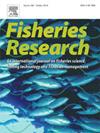In hot water: How marine heatwaves are transforming the recreational albacore fishery in the eastern North Pacific
IF 2.3
2区 农林科学
Q2 FISHERIES
引用次数: 0
Abstract
Albacore tuna (Thunnus alalunga: Scombridae) are a socioeconomically important species globally. A portion of albacore in the North Pacific stock recruit to the California Current Large Marine Ecosystem as juveniles, where they undertake seasonal inshore-offshore migrations. A series of marine heatwaves starting in 2014–2016 produced unprecedented oceanographic conditions in the northern California Current Large Marine Ecosystem, during which time recreational albacore landings in Washington State increased by 950.2 %. Fishing effort in this fishery increased by 1109.7 % during the same time period. We used Generalized Additive Mixed Models to show that a thermal habitat compression index was strongly associated with this increase in landings. During marine heatwaves albacore thermal habitat likely became more available closer to shore, and recreational fishers appeared to opportunistically increase fishing intensity to target them. In contrast, the catch per unit of effort (fish per trip) in this fishery was hyperstable, and less responsive to environmental drivers. While our results show that landings rose sharply during a recent period of ocean warming, effort from smaller private fishing vessels has been increasing since 2012, suggesting that social drivers of effort and participation are also important in this fishery. Given the complex behaviours of both albacore and fishing fleets, their response to future climate change will be more complicated than a simple function of sea surface temperature. However, this emergent fishery may represent an increasingly important source of supplemental revenue in coastal communities where other historically important fisheries are declining.
在热水中:海洋热浪如何改变北太平洋东部的休闲长鳍鱼渔业
长鳍金枪鱼(学名:Thunnus alalunga; Scombridae)是全球重要的社会经济物种。北太平洋长鳍金枪鱼的一部分在幼年时被招募到加利福尼亚洋流大海洋生态系统,在那里它们进行季节性的近海迁徙。2014-2016年开始的一系列海洋热浪在北加州洋流大型海洋生态系统中产生了前所未有的海洋状况,在此期间华盛顿州的休闲长鳍金枪鱼登陆量增加了950.2% %。同一时期,该渔场的渔获量增加了1109.7% %。我们使用广义加性混合模型表明,热生境压缩指数与着陆次数的增加密切相关。在海洋热浪期间,长鳍金枪鱼的热栖息地可能更靠近海岸,休闲渔民似乎会机会性地增加捕捞强度来瞄准它们。相比之下,该渔业的单位努力渔获量(每次行程渔获量)非常稳定,对环境驱动因素的反应较小。虽然我们的研究结果显示,在最近的海洋变暖期间,登陆量急剧上升,但自2012年以来,小型私人渔船的努力一直在增加,这表明努力和参与的社会驱动因素在这种渔业中也很重要。鉴于长鳍金枪鱼和捕鱼船队的复杂行为,它们对未来气候变化的反应将比海面温度的简单函数更为复杂。然而,在其他历史上重要的渔业正在下降的沿海社区,这种新兴渔业可能是一个越来越重要的补充收入来源。
本文章由计算机程序翻译,如有差异,请以英文原文为准。
求助全文
约1分钟内获得全文
求助全文
来源期刊

Fisheries Research
农林科学-渔业
CiteScore
4.50
自引率
16.70%
发文量
294
审稿时长
15 weeks
期刊介绍:
This journal provides an international forum for the publication of papers in the areas of fisheries science, fishing technology, fisheries management and relevant socio-economics. The scope covers fisheries in salt, brackish and freshwater systems, and all aspects of associated ecology, environmental aspects of fisheries, and economics. Both theoretical and practical papers are acceptable, including laboratory and field experimental studies relevant to fisheries. Papers on the conservation of exploitable living resources are welcome. Review and Viewpoint articles are also published. As the specified areas inevitably impinge on and interrelate with each other, the approach of the journal is multidisciplinary, and authors are encouraged to emphasise the relevance of their own work to that of other disciplines. The journal is intended for fisheries scientists, biological oceanographers, gear technologists, economists, managers, administrators, policy makers and legislators.
 求助内容:
求助内容: 应助结果提醒方式:
应助结果提醒方式:


